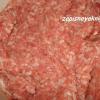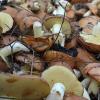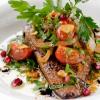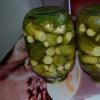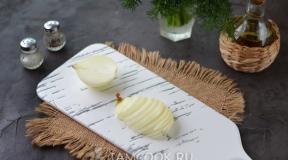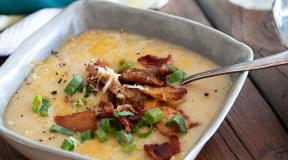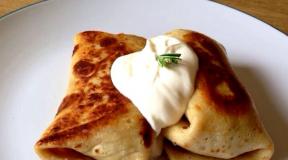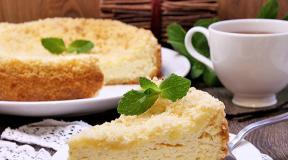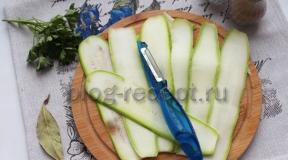Technological operations for bottling water. Mineral water bottling technology
Departmental regulations
technological design of bottling plants
mineral waters
Introduction date 1986-04-01
DEVELOPED by the State Institute for the Design of Food Industry Enterprises "Sevkavgipropishcheprom" of the State Agrarian Industry of the USSR.
Performers: Yu.M. Zharko (topic leader), V.P. Ivakh, S.A. Antonyants, Yu.I. Rodionov, N.E. Miroshnikov, B.D. Klochkov, V.B. Labzin, S.M. Belenky is a candidate of technical sciences (responsible executors).
INTRODUCED by the Subdivision of Design Organizations of the USSR State Agrarian Industry.
AGREED: Gosstroy of the USSR and State Committee on Science and Technology No. 45-162 of 01/31/86.
Research and Production Association of the Beer and Non-Alcoholic Industry No. 1-14/2700 dated 11/15/84.
Gipropishcheprom-2 of the Ministry of Food Industry of the USSR No. С-101/1371 dated 02.08.85
Central Committee of the Trade Union of Food Industry Workers No. 09-M dated 13.06.85
The Main Directorate of Fire Protection of the Ministry of Internal Affairs of the USSR No. 7/6/2887 of 06/24/85
Ministry of Health of the USSR No. 123-12 / 539-6 dated 18.06.85
PREPARED for approval by the Institute for the Design of Food Industry Enterprises "Sevkavgipropishcheprom"
Mineral water bottling shop with water storage and treatment departments (filtration, cooling, disinfection, carbonation), glassware shop;
Shop for finished products (expedition), station for loading mineral water into rail and road tanks; station for draining mineral water from road or railway tanks.
Production laboratory;
Compressor - refrigeration and air;
Repair and mechanical workshop;
Workshop for the repair of transport containers;
Electric charging;
material warehouse;
Administrative and amenity premises.
3. WORKING MODE OF THE ENTERPRISE, DETERMINATION OF THE PRODUCTION CAPACITY OF THE MINERAL WATER BOTTLE PLANT
Fund of working time in hours - 2584;
Number of working days per year - 238;
Number of work shifts per year - 1 - 2
The duration of the shift is 8 hours;
Working hours of workers in shifts, with a break;
The duration of scheduled preventive maintenance of equipment is 20 days.
The fund of equipment operation time is determined taking into account the coefficient of its use equal to 0.75 - 0.9 (see section).
A 1,2,3 - passport capacity of the installed bottling equipment of various brands, bottles per hour;
H 1,2,3 - the number of filling machines of the same capacity;
K 1,2,3 - coefficient of the technical norm for the use of equipment ( K 1,2,3 = 0,9);
T- the number of working hours per shift.
Note: when bottling mineral waters into bottles with a capacity of 0.33 liters, it is necessary to make an appropriate recalculation for a 0.5 liter bottle. When developing new bottling lines, the utilization rate of machines may be less and is taken in accordance with the recommendations of the machine manufacturer.
4. SELECTION OF TECHNOLOGICAL SCHEMES
a) transportation (supply of water from the source to storage tanks (pipeline, tank truck);
b) water storage;
c) water treatment (filtration, cooling, disinfection, carbonation);
d) bottling and capping of water;
e) marriage;
f) labeling;
g) stacking finished products in boxes;
h) transportation of mineral water to the finished product shop;
i) product storage;
j) quality control of mineral water and finished products.
Technological scheme 2 - for carbonic mineral waters similar to scheme 1, but only water transportation under conditions that exclude degassing; storage under hermetic conditions and carbonation without deaeration stage in saturators.
Technological scheme 3 - for mineral waters containing iron (II) compounds.
a) supply of water from the source to the reservoirs under conditions that exclude degassing, in road tanks under an overpressure of carbon dioxide of 0.02 MPa. Before pouring water from the truck tank, the air is completely displaced by carbon dioxide.
At the drain station:
b) preparation of working solutions of stabilizing acids;
c) displacement (draining) of carbon dioxide from mineral water from a tank truck into a receiving sealed tank;
d) introduction of stabilizing additives of food acids into a receiving tank for storing mineral water (it is allowed to introduce stabilizing additives into road tanks before filling them with mineral water);
e) storage, processing of mineral water, bottling and subsequent operations similar to scheme 1.
Technological scheme 4 for mineral waters containing hydrogen sulfide or hydrosulfite - ions.
The scheme is similar to scheme 1, only before storage and processing, sulfur-containing compounds must be displaced from mineral water by bubbling water with carbon dioxide.
Technological scheme 5 for mineral waters containing sulfate reducing bacteria.
The scheme is similar to scheme 1, only when treating mineral water, disinfection is carried out with chlorine-containing solutions.
Note: The introduction of "active" chlorine is carried out before filtration using dispensers. The dose of active chlorine is determined by the chlorine absorption of mineral water, the residual concentration of chlorine in water should not exceed 0.3 ± 0.05 mg/l, 30 minutes after chlorination. The preparation of a chlorine-containing solution (sodium hypochlorite) is carried out in an electrolysis plant (see paragraph 9.17.20).
5. CONSUMPTION RATES FOR RAW MATERIALS AND AUXILIARY MATERIALS
The quality indicators of raw materials and auxiliary materials should be taken in accordance with the requirements of state and industry standards, technical specifications, and in their absence, according to the indicators prevailing in the industry.
The consumption rate of mineral water per one thousand bottles of 0.5 liters is 550 liters.
The loss of mineral water is 10%.
Consumption rates and losses of carbon dioxide, auxiliary materials and bottles should be taken according to the current temporary standards at the enterprises of the system of the USSR Ministry of Food Industry.
6. NORMS OF RESERVES OF RAW MATERIALS, BASIC, AUXILIARY MATERIALS AND CONTAINERS
|
Name of raw materials, waste |
stock rate |
Type of storage |
||
|
Mineral water (before bottling) |
2 days |
In the metallic or reinforced concrete tanks |
||
|
Bottles 0.5 l |
8 days |
In stacks, boxes, NSM |
||
|
Crown cap (area utilization factor 0.3) |
2 months |
Outdoor in boxes, bags |
1200 ÷ 1500 |
|
|
Labels |
1 year |
On racks in packs |
1200 ÷ 1500 |
|
|
Dextrin |
2 months |
On pallets in bags |
1200 |
|
|
Caustic soda (NaOH) |
15 days |
in tanks |
||
|
soda ash |
1 month |
On pallets in bags |
1250 |
|
|
Carbon dioxide (CO 2) |
4 days 2 months |
in cylinders in tanks |
7. REQUIREMENTS FOR PROCESS EQUIPMENT AND PROCESS PIPING
a) pipeline;
b) automobile tanks;
c) railway tanks.
tightness to preserve dissolved CO 2 and ion-salt composition of mineral water, prevent bacterial contamination from groundwater suction and exclude formations on the inner walls of pipelines of solid travertine deposits;
the use of corrosion-resistant material to prevent corrosion of its inner surface;
protection of pipelines from the influence of soil corrosion and the effects of stray currents;
optimal modes of speed, pressure, temperature along the entire length of the pipeline with its rational operating mode.
8. REQUIREMENTS FOR LOCATION OF TECHNOLOGICAL EQUIPMENT
The main passages in the places of permanent residence of workers, as well as along the front of the maintenance of control panels (if there are permanent jobs) with a width of at least 2 m;
The main passages along the service front of machines, pumps, devices with control valves, local instrumentation, etc. in the presence of permanent jobs with a width of at least 1.5 m;
Passages between the rows of receiving or storage tanks and the wall - 0.8 m;
The distance between the tanks in a row is not less than 0.4 m; between paired rows of tanks not less than 0.8 m;
The main passages for maintenance between the tanks are at least 1.8 m;
The distance between the top of the tank and the protruding floor structures is at least 1.0 m.
a) for water with a total mineralization of not more than 8.5 g/l on ceramic filters;
b) for water with higher salinity on lamellar filters.
The first stage of cooling, if possible, should be carried out at mineral water sources.
Disinfection can be carried out by ultraviolet rays, treatment with silver sulfate, chlorination.
For the use of treatment with silver sulphate, the permission of the chief sanitary doctor of the USSR is required, which is issued individually for each composition of mineral water.
10. BASIC REQUIREMENTS FOR THE DESIGN OF A MINERAL WATER BOTTLE STATION
A- hourly productivity of equipment, thousand bottles;
O- production of mineral water in bottles per year, pcs.;
H- number of shifts per year;
τ - shop hours per day;
K 1 - coefficient taking into account the breakage and rejection of bottles during washing;
K 2 - equipment utilization factor 0.75 - 0.90.
For bottling lines produces. 3 ÷ 6 thousand bottles/hour K 2 = 0,9
11. REQUIREMENTS FOR THE DESIGN OF SHOPS OF GLASS CONTAINERS, FINISHED PRODUCTS AND WAREHOUSES OF AUXILIARY MATERIALS
where W- the number of dishes required to create an 8-day supply, pieces;
Q- the number of manufactured products per year, pieces;
nn = 8);
K 1 - coefficient taking into account the loss of dishes in all production operations, taking into account the conditions of its preparation:
K 1 \u003d 1.0314 - when transporting in a batch way,
K 1 \u003d 1.0793 - when transporting in bulk;
n 1 is the number of working days in a year.
75 boxes should be laid on 1 m 2 of area. Collapsible metal boxes of the YaSM type, hereinafter referred to as YaSM, for 140 bottles must be stacked on top of each other in six tiers. 12 boxes of the YaSM type are laid on 1 m 2.
![]()
where Q days - the number of products produced per day;
n- the number of days for which a stock of dishes is created ( n = 8);
K 1 - coefficient taking into account the loss of dishes in all operations;
K 2 - coefficient taking into account the area for passages (when working with hand trucks 0.25, when working with electric forklifts, stackers - 0.5);
W- the number of dishes stacked on 1 m 2.
Shipment of finished products is carried out in packages formed and linked from polymer, wooden boxes, cardboard boxes and in boxes of the YaSM type.
![]()
where Q days - the number of finished products produced per day (average daily for the year);
n- the number of days for which a stock of finished products is created ( n = -8);
k- coefficient taking into account the area for driveways (when working with hand trucks K= 0.25, when operating electric forklifts and stackers K = 0,5);
W- the number of bottles stacked per 1 m 2.
The area of the warehouse is specified graphically by the layout of the stacks.
12. BASIC REQUIREMENTS FOR THE DESIGN OF WAREHOUSES OF THE MAIN AND AUXILIARY MATERIALS
13. MECHANIZATION OF PRODUCTION OF LOADING AND UNLOADING AND TRANSPORT AND WAREHOUSE (PRTS) WORKS
|
unit. rev. |
Mineral water bottling plant million bottles per year |
||||
|
up to 20 |
up to 50 |
up to 100 |
up to 250 |
||
|
Main production |
|||||
|
PRTS works |
|||||
The calculation of the level of mechanization of PRTS works is carried out according to the methodology of the research laboratory of complex mechanization of the Moscow Technological Institute of the Food Industry.
14. REQUIREMENTS FOR THE DESIGN OF A PRODUCTION LABORATORY
|
Name of premises |
The area of premises (m 2) at the plant with a capacity of million bottles. in year |
||
|
up to 100 |
over 100 |
||
|
Chemical |
|||
|
Microbiological with box |
|||
|
weight |
|||
|
Washing and autoclave |
|||
|
Pantry |
|||
|
Head room laboratory |
|||
|
TOTAL: |
|||
|
Name of production unit and profession |
Number of people |
|
|
Head laboratory |
||
|
chemical engineer |
||
|
Bacteriologist |
||
|
Senior Assistant |
||
|
laboratory assistant |
||
|
Sanitary engineer |
||
|
TOTAL: |
15. REQUIREMENTS FOR MECHANICAL REPAIR WORKSHOP AND CHARGING STATIONS
16. RATES OF CONSUMPTION OF WATER, STEAM, COLD, AIR
The costs of water, steam, electricity and carbon dioxide for technological processes must be taken according to the passport data of the equipment being installed.
The determination of the cold consumption for cooling mineral water before saturation is carried out according to generally accepted thermotechnical formulas.
Specific consumption of water, steam, electricity per 1000 bottles is determined by the formula:
![]()
where Q about. - unit costs per 1000 bottles. (0.5 l);
Q g - annual expenses;
n- productivity of the plant bottles/year;
Q d - is defined as the product of the amounts of hourly costs (water, steam, electricity) used for technological processes, equipment washing, auxiliary and household needs, by the number of hours of work per shift and the number of shifts per year.
In the enlarged calculations of the need for energy resources, it is necessary to take the specific consumption of water, steam, cold, electricity, CO 2 and compressed air according to unit cost table.
Water consumption for washing process equipment should be taken as 0.1 m 3 per 1000 bottles. bottling, for rinsing railway tanks 9 m 3 per 1 tank, for washing the floors of industrial premises 3 liters per 1 m 2 of floors.
17. SPECIFIC COSTS FOR TECHNOLOGICAL NEEDS IN BOTTLE MINERAL WATER, SPECIFIC AREA
|
Name |
unit. rev. |
Specific costs per 1000 bottles. |
||||
|
For bottling plants of mineral water with an annual capacity of million bottles. |
||||||
|
Water |
m 3 |
|||||
|
Steam |
kg |
|||||
|
Cold (per 1° water cooling) |
mJ ∙ °С |
2,76 |
2,47 |
2,41 |
||
|
Electricity |
kWh |
|||||
|
carbon dioxide |
kg |
|||||
|
Compressed air |
m 3 |
|||||
Average specific consumption rates for steam, water, electricity, cold per 1000 bottles. bottling of mineral water are compiled on the basis of the experience of operating enterprises and projects of mineral water bottling plants developed by the Sevkavgipropishcheprom Institute.
17.1. Specific indicators of the areas of workshops of the main production of mineral water bottling plants (excluding warehouses for containers and finished products)
|
Plant annual capacity |
Specific area, m 2 - million bottles |
|
|
20 million bottles 0.5 l |
||
|
fifty -"- |
||
|
100 -"- |
||
|
250 -»- |
Average specific indicators of areas per 1 million bottles. bottling of mineral water are compiled on the basis of approved projects of mineral water bottling plants.
18. SCIENTIFIC ORGANIZATION OF LABOR
19. QUALIFICATION LIST OF WORKERS OF THE MAIN PRODUCTION AND SANITARY CATEGORY BY PROFESSION
|
Profession name |
Note |
||
|
Kitchenware workshop |
|||
|
Acceptor-deliverer |
Ranks are accepted according to the tariff-qualification directory of works and professions, approved by the State Committee of the Council of Ministers of the USSR for Labor and Wages |
||
|
Electric forklift driver |
|||
|
stacker-packer |
|||
|
Bottle extractor operator |
|||
|
transporter |
|||
|
Finished Products Workshop |
|||
|
Loader driver |
|||
|
transporter |
|||
|
stacker-packer |
|||
|
Machinist on bag collectors, on automatic packing machines for bottles in boxes |
|||
|
auxiliary transport worker |
|||
|
Storekeeper |
|||
|
Water treatment department |
|||
|
Saturator |
IIc |
||
|
water handler |
IIc |
||
|
Alkali solution regenerator |
|||
|
Bottling shop |
|||
|
Washing machine operator |
IIc |
||
|
Filling and capping machine operator |
IIc |
||
|
Washed bottle controller |
|||
|
Finished product bottle controllers |
|||
|
water handler |
IIc |
||
|
auxiliary transport worker |
|||
|
Adjuster of machines and equipment |
|||
|
Kleevar |
|||
|
loading station |
|||
|
water handler |
IIc |
||
|
support worker |
IIc |
||
|
Repair and mechanical workshops |
|||
|
Turner |
|||
|
Planer |
|||
|
Repairman |
|||
|
Toolmaker |
|||
|
blacksmith welder |
|||
|
support worker |
|||
|
Remstroygroup |
|||
|
Mason |
|||
|
Painter |
|||
|
Glazier |
|||
|
support worker |
|||
|
box shop |
|||
|
machinist |
|||
|
Assembler of parts and wood products |
|||
|
support worker |
|||
|
Electric charging |
|||
|
Accumulator |
|||
|
Repairman |
20. REQUIREMENTS FOR THE TERRITORY, INDUSTRIAL BUILDINGS AND FACILITIES
21. WATER SUPPLY AND SEWERAGE
Water supplied to bottle washing machines should have a hardness of no more than 3.5 meq/l. If the hardness of the source water is more than 3.5 mg-eq / l, water softening should be provided.
The placement of ladders and funnels and their number should ensure the removal of wastewater from the equipment, excluding their spreading on the floor. The floor area for 1 ladder should not exceed 150 m2.
22. HEATING AND VENTILATION
In domestic and auxiliary buildings and structures - heating by local heating devices.
|
Name of premises |
Air temperature, °С |
Air exchange rate m 3 / hour |
||
|
inflow |
hood |
|||
|
Bottling shop |
||||
|
Glass container workshop (heated) |
||||
|
Water treatment department |
By calculation |
|||
|
Alkali regeneration department |
||||
|
Finished Products Workshop |
||||
Note: The air temperatures in the rooms indicated in the table are calculated for the cold and transitional periods. In the warm season, it should be taken according to SNiP "Heating, ventilation and air conditioning". In the shop of finished products, the calculated winter temperature is given, the summer temperature is not standardized.
23. SUPPLYING MINERAL WATER BOTTLE PLANTS WITH CARBON DIOXIDE
Creation of a gas cushion in transport and stationary containers during the transportation and storage of mineral water, as well as in filling machines;
Vodka is a strong alcoholic drink prepared by mixing rectified ethyl alcohol and water, followed by processing the water-alcohol mixture.
Varieties of vodka differ from each other in strength, i.e. the content of ethyl alcohol, the quality of the raw material used - rectified alcohol and some additives (sugar, sodium acetate) used to soften the taste and improve the smell. 40% vodka is prepared on rectified spirit, all other varieties of vodka are prepared on rectified spirit of the highest purity. When preparing “Moscow special” vodka, acetic acid and sodium bicarbonate are added, from which sodium acetate is formed; when preparing “capital” vodka, sugar is added.
The production of vodka consists of the following operations: acceptance of alcohol, preparation (correction) of water, preparation of a water-alcohol mixture (sorting), filtration of a water-alcohol mixture, processing of a water-alcohol mixture with activated carbon and re-filtration, bringing vodka to a standard strength, bottling vodka (picture 1).
Figure 1 - Scheme of vodka production
Acceptance of alcohol
Rectified alcohol is taken by volume, which is measured with conical (from 250 to 1000 dal) and cylindrical (75 dal) measuring gauges. Simultaneously with the measurement of volume, the strength of alcohol is also measured, as in alcohol production. For the acceptance of alcohol at the factories, alcohol-receiving departments (workshops) are equipped. Alcohol is drained from tankers through the lower fitting through a rubber hose. Alcohol is drained from railway tanks using a pump or by gravity. The first method is used only in the case of the location of receiving measuring tanks above the level of railway tanks. When receiving measuring tanks are located below the level of railway tanks, alcohol is drained using a siphon installation (Figure 2), consisting of a rubber corrugated hose, a hand pump and a funnel. One end of the pipe 1, equipped with a tubular tip, is immersed in the tank 2 to the bottom, and the other is connected to the drain communication 3. The valves 4 and 5 are opened and with the valves 6 and 7 closed and all the valves connecting this communication with the conical 8 and cylindrical 9 dipsticks, with the help of a pump 10 or a vacuum, alcohol is sucked out of the tank. As soon as alcohol appears in the drain funnel 11, the pump is stopped, the valve 7 and the valve in front of the conical metering device are opened, into which alcohol must flow.
The use of an installation of three measuring tanks makes it possible to quickly receive alcohol with the necessary measurements and calculations. During the filling of one of the measuring tanks, from the second, alcohol is downloaded through the receiving tank 12 using an alcohol pump 13 into the tanks of the alcohol storage.
 Figure 2 - Scheme of the alcohol-receiving department with a siphon installation for draining alcohol
Figure 2 - Scheme of the alcohol-receiving department with a siphon installation for draining alcohol Water and its preparation
Water must meet the requirements of drinking water, not contain harmful impurities, must be colorless, transparent, odorless and taste good. The total hardness of water should not exceed 1.60483 mg-eq / l (4.5 °) and temporary - 0.35663 mg-eq / l (1 0). If the hardness of the water exceeds the established limits, then it is corrected, i.e. soften with sodium cationite or soda-lime method.
The soda-lime method is rarely used due to the significant consumption of reagents and bulky equipment. The sodium cationite method makes it possible to obtain corrected water with a minimum hardness of 0.07132-0.178-30 meq/l (0.2-0.5°). Cation exchange plant is simple in design, compact and easy to maintain. When water with high temporary hardness enters, a combined method is used. The treatment is first carried out by the soda-lime method, and then by sodium cationization. Instead of the combined method, you can use the Na-H-cationization method or, using only the sodium cation exchange method, neutralize the corrected water with mineral acids (HCl or H 2 SO 4).
Preparation of water-alcohol mixture
Sorting is done in the following way. In a hermetically sealed vat, called a sorting vat, a calculated amount of alcohol is taken from the measuring tanks according to the required sorting strength, and then water is added until a given sorting volume is obtained. After adding water to the vat, thorough mixing is carried out using a stirrer or pumping method, or bubbling with compressed air (Figure 3).
Agitation air is supplied from a compressor or blower through a beam bubbler with 1.5 mm holes. Air consumption is about 1 m 3 per 1 m 2 of the cross section of the tub per minute. Alcohol traps must be installed to capture alcohol from the air leaving the sorting vats.
In the alcohol compartment above the mixer tub, a conical and cylindrical measuring cups, return product chunks, softened water measuring cup, a cup for sodium bicarbonate (soda) solution, and a pump (in an explosion-proof design) are installed on the site for sorting pumping into a pressure tank in front of the filters.
 1 - softened water gauge; 2 - a cup of soda solution; 3 - a collection of returnable products; 4, 5 - measuring cups of alcohol; 6 - vat-mixer; 7 - pump
1 - softened water gauge; 2 - a cup of soda solution; 3 - a collection of returnable products; 4, 5 - measuring cups of alcohol; 6 - vat-mixer; 7 - pump Figure 3 - Scheme of preparation of sorting in a periodic way
A method of continuous sorting preparation is known. For this, a mixer is used, into which water and alcohol are continuously introduced through bubblers at a constant temperature and pressure, adjusting the flow with the help of taps. Below is a diagram of an installation for continuous automated preparation of sorting.
Alcohol and softened water, respectively, from tanks 1 and 2 enter pressure tanks 3 and 4, equipped with float level controls (Figure 4). The flows of alcohol and water are measured with glass rotameters (type Rs-2.5Zh and RS-4Zh), regulated by valves 23 and 25, and mixed in mixer 9, equipped with manifold 8, which serves to distribute water. The ratio of the flows of alcohol and water is taken such that the strength of the sorting after the mixer was 0.5-1.5% vol. above 40% (1: 1.38-1.44). Finally, it is brought with water coming from the pressure tank 4 through the rotameter 7 (RS-0.63Zh) and the actuator 16 into the product pipeline in front of the pump 11. The operation of the pump is controlled using a technical pressure and vacuum gauge 10, and the performance is regulated by the valve 29.
A flow-through pneumatic sensor 14 is used to determine the strength of the sorting and to work out the corresponding pneumatic signal. The selection of sorting to the sensor after the pump is carried out by valves 26 and 27 through the filter-gas separator 13. The sorting flow rate is measured by a rotameter 17. The total pneumatic signal processed by the density sensor enters the control unit and regulation 15, consisting of a secondary device and a proportional-integral controller, and then to the actuator 16.
The secondary device is equipped with a push-button device for controlling the operation of the installation in manual and automatic modes.
 1 - alcohol capacity; 2 - capacity of softened water; 3 - pressure tank with alcohol level regulator; 4 - pressure tank with a water level regulator; 5 - alcohol flow meter; 6 - water flow meter; 7 - additional water flow meter; 8 - collector; 9 - mixer; 10 - manovacuummeter; 11 - centrifugal pump; 12, 34, 35 - pressure gauge; 13 - filter-gas separator; 14 - density sensor; 15 - block of control and regulation of density; 16 - pneumatic actuator; 17 - flow meter of the solution taken to the sensor; 18, 30, 33 - shut-off and control valves; 19, 20, 21, 22 - shut-off valves; 23, 24, 25 - valves that regulate the flow of components; 26-29 - valves that regulate the selection of gas from the sorting and its supply to the density sensor; 31 - remote control panel; 32 - filter for air purification.
1 - alcohol capacity; 2 - capacity of softened water; 3 - pressure tank with alcohol level regulator; 4 - pressure tank with a water level regulator; 5 - alcohol flow meter; 6 - water flow meter; 7 - additional water flow meter; 8 - collector; 9 - mixer; 10 - manovacuummeter; 11 - centrifugal pump; 12, 34, 35 - pressure gauge; 13 - filter-gas separator; 14 - density sensor; 15 - block of control and regulation of density; 16 - pneumatic actuator; 17 - flow meter of the solution taken to the sensor; 18, 30, 33 - shut-off and control valves; 19, 20, 21, 22 - shut-off valves; 23, 24, 25 - valves that regulate the flow of components; 26-29 - valves that regulate the selection of gas from the sorting and its supply to the density sensor; 31 - remote control panel; 32 - filter for air purification. Figure 4 - Scheme of a continuously operating installation for the preparation of sorts
If an imbalance occurs between the current value of the density and the set one, the controller of block 15 changes the output pneumatic signal, which ensures a corresponding change in the position of the valve in the actuator in the direction of equalizing the obtained strength with the given one.
The continuous sorting plant is completely sealed, which reduces the loss of alcohol by 0.03% compared to the batch method. Its compactness allows to reduce the production area.
Calculation of the amount of alcohol and water for the preparation of a water-alcohol mixture
The amount of alcohol required to prepare the sorting is calculated by the formula:

V cn and V grade - respectively, the volume of alcohol and sorting;
a cn and a grade - alcohol strength and sorting
Filtration of water-alcohol mixture
To remove suspended particles, the water-alcohol mixture is filtered twice: before treatment and after treatment with active carbon.
Quartz sand is used as a filter material. Filtration is carried out under the pressure of a liquid column using sand filters, in which quartz sand is placed on a mesh partition covered with a filter cloth made of flannel or cloth.
Filtration of the water-alcohol mixture occurs under the pressure of the liquid column, sorting enters the filter by gravity from the pressure tank located above the filters. As the amount of filtered liquid increases, the height of the sediment layer on the filter material increases. The flow resistance increases and the filtration rate decreases. To eliminate this, the filter is periodically cleaned. Filtration of the water-alcohol mixture through quartz sand is carried out on sand filters (Figure 5).
 1 - body; 2 - bottom; 3 - cover; 4 - supply fitting; 5 - outlet pipe; 6 - lantern; 7 - crane - air vent; 8 - descent fitting
1 - body; 2 - bottom; 3 - cover; 4 - supply fitting; 5 - outlet pipe; 6 - lantern; 7 - crane - air vent; 8 - descent fitting Figure 5 - Sand filter with control lamp
The sand filter is made of sheet copper in the form of a cylindrical body 1, tinned inside, with a spherical bottom 2 and a removable cover 3, bolted to the body flange. Filter height 1100 mm, diameter 700 mm. With the help of two removable tinned perforated discs resting on rings attached to the body, the filter is divided into three chambers: the upper and lower chambers are free, the middle one is filled with quartz sand in two layers with a total height of 700 mm. In the lower layer, the grains have a size of 1 to 3.5 mm, in the upper - 3.5-5 mm. Before filling with sand, a tinned copper or wooden hoop, covered with flannel or overcoat cloth, is placed on the lower disk. The same hoops are placed between the layers of sand and above the upper disk. The gaps between the hoops and the filter housing are clogged with a cotton swab.
The sorting to be filtered enters through the fitting 4 with a tap, passes through the filter chamber and is discharged through the branch pipe 5 for processing with active carbon.
Sand filters for vodka filtration differ in that they are made of stainless steel, equipped with a rotameter and a glass lamp 6 on the outlet pipe. A rotameter controls the filtration rate, and a lantern controls the transparency of vodka.
The first, cloudy portions of the filtrate are returned to the mixer vat. After obtaining a clean filtrate, filtration is carried out at a rate of 0.77 m/h (30 dal/h), adjusting it by smoothly turning the filling valve.
After the filter has been operating for 20-30 days (the speed with the tap open becomes low), it is turned off for recharging.
Several types of sand filters are known, which are widely used for filtering sortings in the alcoholic beverage industry. They are divided by design into single-flow and double-flow.
In single-flow sand filters, sorting is fed from above and discharged from below (Figure 6). The double-flow sand filter (Figure 7) is additionally equipped with a tubular drainage device, the pipes of which are wrapped with a fine mesh with an opening of 0.2-.03 mm. The lower layer of sand with grains of 2-3 mm has a height of 50 mm, the middle layer with grains of 1.5-2 mm has the same height, and the upper layer with grains of 0.5-1 mm has a height of 400-600 mm. The drainage device is located in the middle of this layer of sand. Sorting enters the filter from below and from above and is discharged through the drainage system. The sorting stream coming from below is filtered first through coarse, then through medium and finally through fine grains of sand. The top stream of sorting is filtered only through small grains.
 1 - body; 2 - supply fitting with a distributing device; 3 - outlet fitting; 4 - drainage device; 5 - switchgear; 6 - partition; 7 - top layer of sand; 8 - middle layer; 9 - bottom layer
1 - body; 2 - supply fitting with a distributing device; 3 - outlet fitting; 4 - drainage device; 5 - switchgear; 6 - partition; 7 - top layer of sand; 8 - middle layer; 9 - bottom layer Figure 6 - Single Flow Sand Filter
 1 - body; 2 - switchgears; 3 - partition; 4 - outlet pipe; 5 - window; 6 - drainage device; 7 - top layer; 8 - middle layer; 9 - bottom layer
1 - body; 2 - switchgears; 3 - partition; 4 - outlet pipe; 5 - window; 6 - drainage device; 7 - top layer; 8 - middle layer; 9 - bottom layer Figure 7 - Dual Flow Sand Filter
Sand regeneration in single-flow and double-flow filters is carried out by reverse flow of water: sorting during preliminary filtration, vodka - during final filtration within 10-12 minutes.
Ceramic filters are also used, in which the filter element is ceramic tiles. Regeneration of ceramic tiles is carried out by treatment with hydrochloric acid and calcination in a muffle furnace at 500-600°C.
Treatment of water-alcohol mixture with active carbon
To remove impurities from the sorting, which give it an unpleasant taste and smell, it is treated with activated carbon of the BAU brand. In addition to adsorbing some impurities, activated carbon catalyzes the oxidation reactions of alcohol and its impurities with the formation of organic acids and their subsequent esterification, i.e. the formation of esters. Active carbon is loaded into columns made of copper or stainless steel. Sorting is filtered from bottom to top through sequentially connected carbon columns.
Regeneration of spent activated carbon
Impurities of alcohol and water in the process of filtration, accumulating in the pores of the coal, reduce its absorption activity. Columns typically skip between 15,000 and 100,000 sort decals or more. Periodically, it is necessary to restore the adsorption and catalytic capacity of the spent coal. To do this, the spent coal is regenerated in a column with water vapor at 110-130°C. As a result of the treatment, impurities absorbed by the coal are distilled off.
Filtration of vodka
After treatment with active carbon, the vodka is filtered to separate the smallest impurities and obtain a transparent product with a crystal luster. Vodka is filtered in sand or ceramic filters. In the latter, ceramic tiles with a pore size of 40μ serve as a filtering partition.
Bringing vodka to the required strength
The filtered vodka enters the finishing vats, where it is stirred and the strength is checked. If the strength of vodka deviates from the standard, it is brought to the required level by adding alcohol or water. After that, the vodka is sent for bottling.
INTRODUCTION…………………………………………………………………..
1. DESCRIPTION OF THE TECHNOLOGICAL PROCESS………………
2. AUTOMATION OF THE TECHNOLOGICAL PROCESS……..
3. PROGRAMMING THE CONTROLLER…………………………
CONCLUSION………………………………………………………………
INTRODUCTION
Automation of management is one of the main directions for increasing production efficiency. More Yu.V. Andropov noted that it was necessary to carry out the automation of production, to ensure the widespread use of computers and microprocessor technology.
One of the ways to increase the efficiency of energy production is the introduction of computer technology in control systems. The widespread introduction of automated control systems is an objective necessity, due to the complication of management tasks, an increase in the amount of information that needs to be processed in management systems.
To date, any serious enterprise has implemented automated process control systems, and automated control systems perform up to 90% of the tasks of the enterprise.
In the organization of technological process maintenance, local (local) control systems for technological equipment and processes play an important role and are designed to control and manage separate, unrelated objects and form the lower level in a hierarchical control system. These control systems are single-loop and for synchronous control of such systems, from my point of view, it would be best to use a controller in control. Since with the continuous nature of production, the main task of automation is the automatic regulation of parameters, and in discrete production (as is the case with my technological process), software-logical control is most suitable. In this technological process, it should be noted that the workshop produces 5000 bottles of mineral water per hour, and the counting and registration of goods with the help of a working person
Nala may not always be accurate. It should also be noted that if the filling machine is set incorrectly, it leads to product damage (bottle explosion), in order to optimally quickly set it up, information is needed on such indicators as the pressure in the filling machine chamber for certain periods of time (statistics over time), this information registering with the help of working personnel is not always possible with high quality, and with a short time interval (step between reconciliations) is almost impossible. Also, for safety reasons, since this technological process is characterized by high humidity, and all control systems are built on an electric circuit, it is necessary to abandon the controllerless method of controlling the TP. Therefore, I think it is necessary to introduce software-logical control based on the controller and software for it into the TP for bottling mineral water, which will take care of all calculations, registration, measurements and other laborious work.
1. DESCRIPTION OF THE TECHNOLOGICAL PROCESS
The block diagram of the technological process is shown in Figure 1.1 For greater clarity, I have divided this technological process into 10 parts:
1. The first part is a container for imported mineral water (H-1 and H-2). The number of containers is 2 pieces of 24 tons. These containers are taken out of the workshop for the purpose of life safety.
2. The second part is a food electric pump A9-KNA (2 * 105? Pa), which pumps water from the accumulators into the ceramic filters F1 and F2 (the brand is shaded).
3. In the third part of the technological process, I included a freon compressor and a capacitive storage H-3 to cool the water pumped through the centrifugal pump TsN-1, coming from filters F1 and F2, to the optimum temperature of +4 C for mixing imported mineral water with carbon dioxide.
4. The fourth part includes an installation where carbon dioxide cylinders are supplied (pressure in the cylinder is 70 MPa), the cylinders are connected in series. The supply of carbon dioxide is regulated by means of a pneumatic reducer, the outlet pressure for the pneumatic reducer is 2MPa. Flow sensors for visual control are also provided.
5. The fifth part is a saturator, where mineral water is mixed, pumped from the cooling tank H3 using two centrifugal pumps TsN-2 and TsN-3, and carbon dioxide.
6. The sixth part includes an AMMB bottle washing machine for washing and disinfecting containers. For washing bottles, water is supplied to the machine under pressure P = 2 MPa; in the amount of F = 6m3?/min. At the exit, a light screen is provided for visual checking the quality of the washed containers, that is, at the exit from the bottle washing machine. The quality in this case is the integrity of the bottle and its purity.
7. The seventh part of the technological process is the pouring monoblock, it can be divided into three components:
Dosage - for the supply of syrup, if sweet water is produced;
An automatic filling machine for filling liquids under pressure, since in this technological process bottling is carried out not by level (a specific amount of mineral water for each bottle), but by the ratio of pressure in the filling machine chamber and pressure in the bottle;
Capping machine (UB brand) - for capping a bottle with a tin cork.
8. The eighth part is the BA forwarding machine, it serves to detect defects, the quality here is: the capping of the bottle must be done in such a way that the bottle does not crack and must be hermetically closed to prevent degassing, as well as the ingress of foreign bodies, such as particles of dirt, pieces of glass and so on.
9. The ninth includes the labeling machine VEM 614, which is used for automatic labeling. If the filled bottle has passed the forwarding machine, then a label corresponding to the contents of the bottle is pasted on it. In this case, the label should not be fed by tape, but in a pre-cut form.
10. The tenth part is the packaging, completely produced with the help of a working staff of two people.
From one part of the technological process to another, the bottle is fed by a conveyor.
2. AUTOMATION OF THE TECHNOLOGICAL PROCESS
2.1. Description of the extended functional diagram of mineral water bottling automation.
The extended FSA is shown in Figure 2.2.
In this technological process, blocking, signaling and protection schemes are provided. When the level (position 1) reaches the upper or lower level in the filling machine PA, the electric valve (position 1) will be closed or opened respectively.
When the level (position 2) reaches the top or bottom in the saturator, the centrifugal pumps (position 2) will be turned off or on, respectively.
When the level (position 3) reaches the upper or lower level in the cooling tank H-3, the centrifugal pump (position 3) will be turned off or on, respectively.
When the temperature (position 4) reaches the upper or lower in the cooling tank H-3, the electric valve (position 4) will be closed or opened respectively.
Quality control is carried out in the capacity of the filling machine RA (position 5).
3.2. Choice of automation tools.
To automate the process, it is necessary to use a number of transducer devices and sensors.
Temperature control is carried out using a thermocouple TKhK - 0179 (item 4-1). To put them into contact, it is necessary to normalize them using the Sh-703 converter (position 4-2). Basic error 0.53 – 1.35%.
The actuator is controlled by buttons PKE - 212C (position 1-6, 1-7,2-6, 2-7, 3-6, 3-7, 4-6, 4-7). From the operator's control panel through the PME-011 magnetic starter (position 1-4, 1-5, 2-4, 2-5, 3-4, 3-5, 4-4, 4-5).
Dr-M (position 1-7, 4-8) are used as executive electric mechanisms. It starts to work on receiving a pulse from the sensor, after which it conducts testing on its own and automatically stops after opening or closing the valve.
To control the quality of mineral water, a concentration analyzer DKB-1M (position 5-1) is used, with a normalized output signal of 0..5 mA.
To control the level, a LABKO - 2W level gauge is used (position 1-1, 2-1, 3-1). The output signal is normalized using the Sapphire-22DD converter (position 1-2, 2-2, 3-2).
3. PROGRAMMING THE CONTROLLER.
For a better understanding of the program, I presented its algorithm:
In circuits 1, 2, 3 (Figure 2.2.), the level is monitored in the filling machine RA, saturator, cooling tank H-3.
In circuit 4, the temperature in the cooling tank H-3 is controlled.
We accept the following values as code combinations:
| Enter L1 level value from RA |
||
| L1=1 Go to "Close slide on valve (position 1-7)" |
||
| L1 =0.5 m. Go to "Open slide valve (item 1-7)" |
||
| Enter L2 level value from saturator |
||
| L2=2 m Go to "Turn off pumps (item 2-7, 2-8)" |
||
| L2 =0.3 m. Go to "Enable pumps (item 2-7, 2-8)" |
||
| Enter the level value L3 from the cooling tank H-3. |
||
| L3=1.5m Go to "Turn off the pump (item 3-7)" |
||
| L3 =0.2 m. Go to "Turn on the pump (item 3-7)" |
||
| Enter the value of the level T from RA |
||
| T £ 4 0 C Go to "Close slide on valve (item 4-8)" |
||
| T > 4 0 C Go to "Open slide valve (item 4-8)" |
||
| Is there a program exit signal |
||
| If yes, go to "Stop program execution" |
||
| If not, go to the beginning of the program |
||
| Close the slide on the valve (position 1-7) |
||
| Open the gate valve on the valve (position 1-7) |
||
| Turn off pumps (item 2-7, 2-8) |
||
| Turn on the pumps (item 2-7, 2-8) |
||
| Turn off the pump (item 3-7) |
||
| Turn on the pump (item 3-7) |
||
| Close the gate valve on the valve (item 4-8) |
||
| Open the gate valve on the valve (position 4-8) |
||
| Output level value L1 |
||
| Output level value L2 |
||
| Display L3 level value |
||
| Display temperature T |
||
CONCLUSION
The purpose of this course work was to develop software for a programmable controller to control the process of bottling mineral water.
Mineral waters bottled, depending on the chemical and gas composition, as well as the filling method, are divided into four technological groups: 1) non-carbonated water; 2) carbonic waters; 3) carbonic waters containing iron; 4) hydrosulfite and hydrosulfide-hydrosulfide waters.
The first technological group includes the most stable mineral waters, which do not undergo oxidation during the bottling process and do not change their chemical composition.
The technological scheme for bottling non-carbonated waters belonging to the first technological group is shown in Figure 1.15.
Mineral water from wells 1, under its own pressure or with the help of a deep pump, is supplied to a hermetically sealed collection 3 installed in the capping facility 2. From collection 3, mineral water is pumped by pump 4 to collection 5 for storage and, if necessary, is pumped by pump 4 to ceramic filters 6 , from where it enters the counterflow heat exchanger 7, and then to the intermediate collector. From this collector, water is pumped by pump 4 to saturator 9, where carbon dioxide is supplied from gasification station 35, delivered to the plant in specialized tanks 36. Saturated C0 2 mineral water is sent through a disinfecting installation 10 to the tank of the bottling machine 22. Delivered on pallets 11 in sacks 12 or boxes 13, glass containers are placed in boxes and fed along a 14 belt conveyor to machines for extracting bottles from boxes 15.
The bottles removed from the boxes are fed by a belt conveyor 14 to the loading device of the bottle washing machine 18, while passing by the inspection screen 17. The washed bottles are sent to the viewing screen 17 by the 16 plate conveyor to check the quality of washing. Then the bottles pass sequentially through the filling machine 22, the capping machine 23, the semi-automatic rejection machine 24, the labeling machine 25 and enter the machine for placing bottles in boxes 26, to which empty boxes are fed by a belt conveyor 14. Finished products packed in boxes 27 are stacked on pallets in stacks 28 for transportation to the warehouse of finished products. The concentrated alkali solution is delivered to the plant in tank trucks 29, from which it is pumped by a pump 30 into a collection tank 31 for storage.
As needed, a concentrated alkali solution is pumped from this collector by a pump 30 into a measuring tank 32, from where it enters a tank 33 for preparing a working solution of alkali, or directly pumped into a collecting tank 21. The spent alkali solution is poured into a receiving collector 19 and after settling pump 20 is fed to the filter 34, then to the container for preparing the working solution 33.
The crown cork for capping mineral water bottles is delivered to the factory in 40 bags stacked on 11 pallets. cars.
The second technological group includes mineral waters, the chemical composition of which is subject to change. Since the carbon dioxide contained in them is a stabilizer of the chemical composition, bottling of such waters into bottles must be carried out under conditions of slight overpressure created by CO 2, which will minimize the possibility of degassing.
The technological scheme for bottling mineral waters belonging to the second technological group is identical to the one above, but all technological operations associated with their transportation, storage and bottling are carried out under a slight overpressure of CO 2 .
The third technological group includes waters containing from 5 to 70 mg of iron per 1 liter.
In order to avoid the formation of sediment in the bottle during bottling of these mineral waters, conditions must be provided to prevent the oxidation of iron and the degassing of waters during the bottling process. For this purpose, a solution of stabilizing acids - ascorbic or citric acids - is introduced into the mineral water.
Mineral waters containing iron are classified as shallow circulation waters. They are the most susceptible to bacterial contamination. Secondary water pollution is possible during pumping, storage, processing and bottling. The introduction of organic acids can serve as a source of nutrition for non-toxic microorganisms found in mineral waters, in particular sulfate-reducing ones. Therefore, mineral waters containing iron must be subject to mandatory disinfection. The content of CO 2 in the finished product must be at least 0.4% by weight, and for capping them, only crown corks with gaskets made of polymeric materials should be used.
Bottling of ferruginous mineral waters related to the third technological scheme is carried out according to the generally accepted technological scheme shown in Figure 1.2
An additional process of stabilizing the chemical composition of water during bottling is carried out according to the following technological scheme. Mineral water from well 1, located in the overhead structure 6, enters a hermetically sealed collection 3, equipped with a safety valve 2 and a pressure gauge. From this collector, water is pumped by pump 4 to collector 5, from where it is transferred to production. A solution of stabilizing acid is introduced into the supply pipeline to the collector 5, the concentrated solution of which is in the collector 8. The working solution is prepared in collectors 7 equipped with mixers.
Figure 1.2 Technological scheme for bottling non-carbonated mineral waters belonging to the first technological group
In the case of transportation of mineral waters containing iron, at a distance of up to 200 km, sealed tankers are used, from which air is first displaced by carbon dioxide supplied from carbon dioxide cylinders. In this case, the stabilizing solution is introduced into a tank or intermediate container, from which air is also pre-displaced.
When two-chamber tank trucks are used for transportation, CO 2 is sequentially displaced and each chamber is filled with water separately. The completeness of the displacement of air from the tanks and the intermediate tank is checked by the turbidity of barite or lime water, through which the air coming out of the tanks or the intermediate tank is bubbled. After the complete displacement of air from the tanks or the intermediate tank, the supply of CO 2 is stopped. Tank trucks are filled with mineral water to 9/10 of the volume. Transportation of mineral water is carried out under a slight overpressure of CO 2 .
For bottling hydrosulfide-hydrosulfide and hydrosulfite waters, united in the fourth technological group, mineral waters with a hydrogen sulfide content of up to 20 mg/l and hydrosulfides up to 30 mg/l can be used. Since the reduced forms of sulfur contained in these waters are prone to oxidation with the formation of colloidal sulfur, which causes water opalescence, and, in addition, neither hydrogen sulfide nor hydrosulfidions are useful components of water, a technological method is introduced into the technological scheme for bottling such waters, aimed at removing them from the composition of mineral waters.
The bottling of mineral waters, united in the fourth technological group, is carried out according to the technological scheme shown in Figure 1.15, with additional water treatment in a scrubber. To do this, mineral water from the storage tank is pumped into the upper part of the scrubber filled with Raschig rings. At the same time, CO 2 is fed into the lower part of the scrubber. Water flowing down in a thin layer over the surface of the rings. Rashig, intensively contacts with CO 2 , while the equilibrium shifts towards the formation of hydrogen sulfide, which is carried out of the mineral water by a current of carbon dioxide. The pumped desulphurized water is sent to a storage tank, while the carbon dioxide from the scrubber can be treated and reused.
Shop for bottling drinking water into bottles of various volumes:
The diagram below shows bottling shop- the option of placing a water bottling line with a capacity of 80 bottles per hour in the maximum configuration. That is, a thermotunnel for shrinking caps and a packer for 19-liter bottles in PE bags are optional equipment and are purchased at the request of the customer.
This scheme of the bottling shop is exemplary - for a preliminary understanding of the required dimensions of the room. To order a detailed layout of equipment in production areas for your business, 
The diagram below shows a 19 liter bottling equipment arrangement with a capacity of 150 bottles per hour. The basis of such a line is QGF-150 WellSpring. 
The last diagram shows a placement option with a capacity of 240 bottles per hour. 
These schemes are typical and are given on our website as an example. The engineers of our Service Center will develop a project for placing a bottling line for water and drinks at production facilities specifically for your company, taking into account productivity and with a supply of communications.
Layout of equipment in the bottling shop "": 
in a bottle of 19 liters, as a rule, includes the following set of equipment:
| Automatic bottling line (productive) | detailed information | |
| 1 | Old cork remover |
The quite understandable desire of the population of large cities to consume environmentally friendly "living" water is actively supported by its producers, who are organizing the production of bottling water and supplying this kind of "fuel" both to offices and private clients. To organize a small business for the production of bottled drinking water (water bottling), a production facility is sufficient, in which the entire production process is carried out in two main stages: water purification and bottling of water on special equipment with subsequent group packaging. You can find more information about the process of bottling water in the description of the operation of the equipment on our website. |




